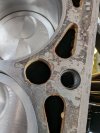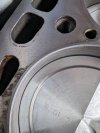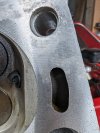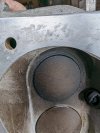You are using an out of date browser. It may not display this or other websites correctly.
You should upgrade or use an alternative browser.
You should upgrade or use an alternative browser.
Head gasket now!!?
- Thread starter FiatFunk
- Start date
Rupunzell
Bernice Loui
Cometic suggest a surface finish of 50 RA or less.From what I understand, to get the proper finish for an MLS gasket you need specialized tooling. I've heard shops using CBN instead of carbide. I would guess that if a shop isn't doing lots of engines that require that finish they may not have the tooling or appreciate the requirements. And if they're not doing a lot of that kind of work they also likely don't have a profilometer to actually verify the surface finish is right. In the last year or so I've seen several of the YouTube engine machinists talk about getting profilometers to verify their work, so I would argue having one isn't pervasive in shops at this point. I hope it doesn't feel like I'm trying to rag on you. Sorry to see the trouble with your engine. But I don't think a MLS job is one where "it should be fine" is correct.
Cometic Gasket - Sealed Under Extreme Pressure
Cometic Gasket supplies hi-performance gaskets for a variety of motorsports markets: ATV, Drag Race, Domestic Automotive, Harley-Davidson®, MX/Dirt, Off-Road, PWC, Road Race, Snowmobile, Sport Compact and Street.
www.cometic.com
Surface finish of 50 RA or less is not difficult, do this all the time in aluminum using carbide inserts specific for aluminum.
For turning CCGT/CCMT. these are razor sharp with a positive rake, good on aluminum extremely fragile for steel.
Milled surface of less than 32 RA using a Lovejoy surface mill specific for aluminum.
Lovejoy face mill, inserts are positive rake, specific for aluminum. Again, fragile on steel.
Aluminum specific carbide inserts are very common and widely used in machine tools both manual and cnc..
Set up stability, rigidity, feeds and spindle speeds and cutting lube/coolant all figures into this. Honestly, good surface finish is not that difficult for aluminum or cast iron or steel.. Much an issue of using the proper cutting tools, speeds, feeds, good stable-rigid set up on high quality machine tool manual or cnc.
Bernice
Lowtechprime
Retro Grouch
Excellent video Bernice!
FiatFunk
True Classic
Ok I got some better photos of the surfaces I'm dealing with. Please let me know what you think. Personally, I don't like it. I will most definitely not be using an MLS gasket on this. I can feel the ridges with my fingernails, and it is not nearly as smooth as the block I just got back for my 124 (from a different machine shop)
Attachments
Dr.Jeff
True Classic
It's always hard to tell from pics, but just judging from what can be seen it doesn't even look like they took enough off to make it truly flat? Those areas that still show old gasket material and the "pimply" texture must be "depressions" compared to the shinny machined areas. If you get a straight edge be sure to check it in all directions.Ok I got some better photos of the surfaces I'm dealing with. Please let me know what you think. Personally, I don't like it. I will most definitely not be using an MLS gasket on this. I can feel the ridges with my fingernails, and it is not nearly as smooth as the block I just got back for my 124 (from a different machine shop)
FiatFunk
True Classic
I think you're misunderstanding. This is what I'm dealing with after my head gasket and t housing gasket failures. They were clean and fresh surfaces, I assembled it, started and ran it briefly a few times, then had the gasket failures.It's always hard to tell from pics, but just judging from what can be seen it doesn't even look like they took enough off to make it truly flat? Those areas that still show old gasket material and the "pimply" texture must be "depressions" compared to the shinny machined areas. If you get a straight edge be sure to check it in all directions.
I am posting these photos so you guys can pass judgement on the surface finish texture.
jimmyx
True Classic
No, that won't work for an MLS gasket. A stock gasket may work for a couple of thousand miles, but it will have an early failure too. The process of combustion with it's heat and pressure are looking to escape in any way possible. Those machine marks radiate into the combustion chamber of the head and after awhile the pressure finds another outlet between the head/block/gasket and will normally burn through the gasket fire ring. Even conventional gaskets need a fairly smooth surface. Sometimes you can faintly see the machine marks, but if you can catch your fingernail in them it's way too rough. Many machine shops have been doing domestic stuff for years. Cast iron heads on cast iron blocks will tolerate a lot more than an aluminum head on an iron block, so it takes kissing a lot of frogs before you find a shop that understands the finish you need.I can feel the ridges with my fingernails
You also noted that you had oil in one of the exhaust ports. Don't forget to remove the valve spring and insure the seal is fully seated on the guide and not cut as long as the head is already off. You don't want to remove the head again....
Last edited:
Dr.Jeff
True Classic
I understand. It might depend on how you cleaned the surfaces. Is the remaining material just from areas that you haven't cleaned thoroughly? Or is that left after everything has been equally cleaned? What I'm trying to get at is a uneven surface tends to retain more old material than a nice smooth one. Therefore those areas may indicate the surface wasn't refaced enough to achieve a consistent surface texture or roughness evenly throughout, they might indicate "low spots".I think you're misunderstanding. This is what I'm dealing with after my head gasket and t housing gasket failures. They were clean and fresh surfaces, I assembled it, started and ran it briefly a few times, then had the gasket failures.
I am posting these photos so you guys can pass judgement on the surface finish texture.
FiatFunk
True Classic
No they removed almost all of the decompression rings. They took a lot off. By memory it was 40 thouI understand. It might depend on how you cleaned the surfaces. Is the remaining material just from areas that you haven't cleaned thoroughly? Or is that left after everything has been equally cleaned? What I'm trying to get at is a uneven surface tends to retain more old material than a nice smooth one. Therefore those areas may indicate the surface wasn't refaced enough to achieve a consistent surface texture or roughness evenly throughout, they might indicate "low spots".
I only scraped it with a razor blade and if you remember or scroll back to the first photos I posted you will see that there was hardly any traces of gasket left on the front edge of the block, just like these latest photos
Last edited:
FiatFunk
True Classic
That is not what I want to hear. I feel like calling up that shop and giving the guy a piece of my mind. Now I'm the one who has to pull out and tear down the entire block, either now or in a few thousand km. I'm putting it back together and hopefully it fails again later rather than sooner. Do you think a slightly thicker HG would seal better than a thin one?No, that won't work for an MLS gasket. A stock gasket may work for a couple of thousand miles, but it will have an early failure too. The process of combustion with it's heat and pressure are looking to escape in any way possible. Those machine marks radiate into the combustion chamber of the head and after awhile the pressure finds another outlet between the head/block/gasket and will normally burn through the gasket fire ring. Even conventional gaskets need a fairly smooth surface. Sometimes you can faintly see the machine marks, but if you can catch your fingernail in them it's way too rough. Many machine shops have been doing domestic stuff for years. Cast iron heads on cast iron blocks will tolerate a lot more than an aluminum head on an iron block, so it takes kissing a lot of frogs before you find a shop that understands the finish you need.
You also noted that you had oil in one of the exhaust ports. Don't forget to remove the valve spring and insure the seal is fully seated on the guide and not cut as long as the head is already off. You don't want to remove the head again....
jimmyx
True Classic
A stock composite type gasket is the most tolerant of a rougher finish, but when it's so rough you can catch a fingernail that's pretty far over the top. The grooves act like little channels that combustion pressure will eventually turn into an escape route and the thickness or thiness of the gasket really makes no difference.Do you think a slightly thicker HG would seal better than a thin one?
FiatFunk
True Classic
Well ****A stock composite type gasket is the most tolerant of a rougher finish, but when it's so rough you can catch a fingernail that's pretty far over the top. The grooves act like little channels that combustion pressure will eventually turn into an escape route and the thickness or thiness of the gasket really makes no difference.
Lowtechprime
Retro Grouch
I don't see how they could've removed that much, in pic 3 you can still see pitting in the surface?
FiatFunk
True Classic
I sent these photos to Midwest and they agree that these surfaces are super rough. Also I just got off the phone with the machine shop, I tried to be nice and watch my tone and what I said. He says he's been doing this 37 years, all different kinds of vehicles and his finishes are good enough for MLS gaskets. He doesn't see why mine would be any different. But of course everyone else says this is no good. I doubt Fiats require a special finish.
I'm ready to throw the towel in on this entire project, but I'll order a new gasket (maybe two) reassemble and hope for the best.
I'm ready to throw the towel in on this entire project, but I'll order a new gasket (maybe two) reassemble and hope for the best.
Alex(Tenerife)
True Classic
Don't give up.
It sounds like from what people have said here that the finish on the head is too rough. Your machine shop is always going to defend his work.
What I would be tempted to do in your position is while the head is off, take it to a machine shop or 3, show it to them in person. Bring your old head gasket, Find someone who says things that sound right to you and take it from there. Obviously best if they have reasonable experience with ally heads.
I have struggled when I knew less and paid garages to work on my car with struggles on repeated blowing of head gaskets(I didn't know anything about re-torquing head bolts and neither did the garages I took it to), so I sympathise with your dilema and wish you the best of luck but I now subscribe to the do it right and do it once methodology.
It sounds like from what people have said here that the finish on the head is too rough. Your machine shop is always going to defend his work.
What I would be tempted to do in your position is while the head is off, take it to a machine shop or 3, show it to them in person. Bring your old head gasket, Find someone who says things that sound right to you and take it from there. Obviously best if they have reasonable experience with ally heads.
I have struggled when I knew less and paid garages to work on my car with struggles on repeated blowing of head gaskets(I didn't know anything about re-torquing head bolts and neither did the garages I took it to), so I sympathise with your dilema and wish you the best of luck but I now subscribe to the do it right and do it once methodology.
FiatFunk
True Classic
Yeah thanks Alex. I got in this path because I spun a bearing in my Lancia Delta integrale and couldn't afford to pay anyone to fix it, but also because I've seen so much poor workmanship out there. That first engine turned out well and so I got into it. Right now tho I feel like I'm spending all my life in the workshop and getting nothing back. Oh well, head down and it'll come together eventually.Don't give up.
It sounds like from what people have said here that the finish on the head is too rough. Your machine shop is always going to defend his work.
What I would be tempted to do in your position is while the head is off, take it to a machine shop or 3, show it to them in person. Bring your old head gasket, Find someone who says things that sound right to you and take it from there. Obviously best if they have reasonable experience with ally heads.
I have struggled when I knew less and paid garages to work on my car with struggles on repeated blowing of head gaskets(I didn't know anything about re-torquing head bolts and neither did the garages I took it to), so I sympathise with your dilema and wish you the best of luck but I now subscribe to the do it right and do it once methodology.
Midwest suggested just getting the head flat with a straight edge and 300 grit. I may try to find a piece of marble or thick glass. I'd like to bring it to a machine shop but I'm a couple hours away from the closest and they're all so busy/slow. I too am busy and can't just head over there so easily.
Dan Sarandrea (Phila)
Waitin' On Parts...
Was the block resurfaced or does it have the original factory finish?
FiatFunk
True Classic
B
Both resurfaced. Block has the same rough ridged finish. See photos a few posts backWas the block resurfaced or does it have the original factory finish?
FiatFunk
True Classic
So the fiatsco continues....
Since I have the head off I decided to smooth it out with sandpaper and a piece of marble tile. Also I made such a mess getting the cambox gasket off I thought I might as well remove the valves. I had been wishing I did a little more work on porting so now could be a chance to do that, try to make it better while apart.
Now when I first got the car and removed the head, it had a stuck valve. It was stuck open but not super seized, I was able to remove the valve without much effort. I purchased new valve guides and brought them along to the machine shop, told him about this and left it with him. He returned the head to me fully assembled.
Yesterday when I removed the valves, one of them had a lot of friction, I was able to remove it by hand, just by pulling on it, but it felt like the first time around. Unbelievable the utter sh*t work that some shops send back to people! I'm fuming...
Since I have the head off I decided to smooth it out with sandpaper and a piece of marble tile. Also I made such a mess getting the cambox gasket off I thought I might as well remove the valves. I had been wishing I did a little more work on porting so now could be a chance to do that, try to make it better while apart.
Now when I first got the car and removed the head, it had a stuck valve. It was stuck open but not super seized, I was able to remove the valve without much effort. I purchased new valve guides and brought them along to the machine shop, told him about this and left it with him. He returned the head to me fully assembled.
Yesterday when I removed the valves, one of them had a lot of friction, I was able to remove it by hand, just by pulling on it, but it felt like the first time around. Unbelievable the utter sh*t work that some shops send back to people! I'm fuming...




